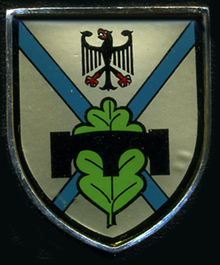Pioneer Command 1
|
Pioneer |
|
|---|---|
 ( did not have an association badge ) |
|
| active | July 1, 1972 to October 1, 1993 |
| Country |
|
| Armed forces |
|
| Armed forces |
|
| Type | Pioneer command |
| Insinuation |
|
| last location | Minden |
The Pioneer Command 1 ( PiKdo 1 ) was one of the pioneer commands of the Army of the Bundeswehr . The pioneer command was part of the corps troops of the I. Corps and was most recently stationed in Minden ( Westphalia ).
assignments
The engineer command bundled the troops of the engineer and NBC defense forces at the corps level . The commanding general of the corps thus had his own engineering means to increase the mobility of the corps troops. Depending on the situation , the engineer battalions of the subordinate divisions and the tank engineer companies of the brigades could be reinforced. In contrast to the last-mentioned units, the pioneer command had "heavy" pioneer equipment that enabled the pioneer commander to enable the crossing of larger bodies of water and to repair the marching roads for the corps' extensive logistics units. Another task was the NBC defense at the corps level. Overall, the size of the pioneer command with about 6000 soldiers in the war organization corresponded to about one of the brigades of the field army .
structure
Around 1989 the pioneer command was roughly divided into:
-
 Staff / Staff Company Pioneer Command 1, Münster
Staff / Staff Company Pioneer Command 1, Münster
-
 Pioneer Battalion 110 (partially active), Minden
Pioneer Battalion 110 (partially active), Minden
-
 Pioneer Battalion 120, Dörverden
Pioneer Battalion 120, Dörverden
-
 Amphibious Pioneer Battalion 130 (partially active), Minden
Amphibious Pioneer Battalion 130 (partially active), Minden
-
 Pioneer Battalion 140, Emmerich am Rhein
Pioneer Battalion 140, Emmerich am Rhein
-
 Pioneer Battalion 150 (GerEinh), Höxter
Pioneer Battalion 150 (GerEinh), Höxter
-
 Swimming bridge battalion 160 (GerEinh and partially active), Minden
Swimming bridge battalion 160 (GerEinh and partially active), Minden
-
 Swimming bridge battalion 170 (GerEinh), Dünsen
Swimming bridge battalion 170 (GerEinh), Dünsen
-
 NBC Defense Battalion 110 (cadre), Emden
NBC Defense Battalion 110 (cadre), Emden
-
history
prehistory
From 1958 to 1959 the post of corp spy commander 701 was planned in Münster . The corpspionier commander 1 was renamed and initially based in Münster between 1959 and 1971, and from 1971 in Minden.
Lineup
The engineer command was set up on July 1, 1972 to take Army Structure III in the Herzog von Braunschweig barracks in Minden. Corp spy commander 1 was called in for the establishment. In 1986 the staff of Pioneer Command 1 moved to the Lützow barracks in Münster - Handorf . From 1990 the staff of the pioneer command was again based in the Herzog von Braunschweig barracks until it was decommissioned.
resolution
After the end of the Cold War , the pioneer command was decommissioned in 1993 at around the same time as the 1st Corps was reclassified as the 1st German-Dutch Corps . The Pioneer Brigade 20 in Minden was reorganized from parts of the Pioneer Command . Some battalions switched to the newly established Pioneer Brigade 30 .
Association badge
Due to its planning as part of the dependent corps troops, the pioneer command did not have its own association badge . The soldiers therefore wore the association badge of the higher corps .
As a "badge", the internal association badge of the staff and the staff company " pars pro toto " was sometimes used imprecisely for the entire pioneer command. Essentially, as a reference to the stationing area, it showed the stylized Minden waterway cross at the traditional pioneering site of Minden . The federal eagle is the German heraldic animal and was also shown in the association badge of the I. Corps . The oak leaf branch is a traditional symbol of German armed forces and, in connection with the stylized bridge also shown, is similar to the beret badge of the pioneer troops . Staff and headquarters company of the "successor association" of Pioneer Brigade 20, later also the staffs and headquarters companies of the "successor" of Pioneer Brigade 100 and Pioneer Regiment 100 , had very similar internal association badges.
Individual evidence
- ↑ a b O.W. Dragoons: The Bundeswehr 1989 . Army Office. I. Corps. II Corps. III. Corps. 4th edition. 2.1 - Army, February 2012 ( religte.com [PDF; accessed August 7, 2019]).
- ^ Bundeswehr location database. In: http://www.zmsbw.de/ . Center for Military History and Social Sciences of the Bundeswehr (ZMSBw), accessed on August 7, 2019 .
Coordinates: 52 ° 17 ' N , 8 ° 52' E
